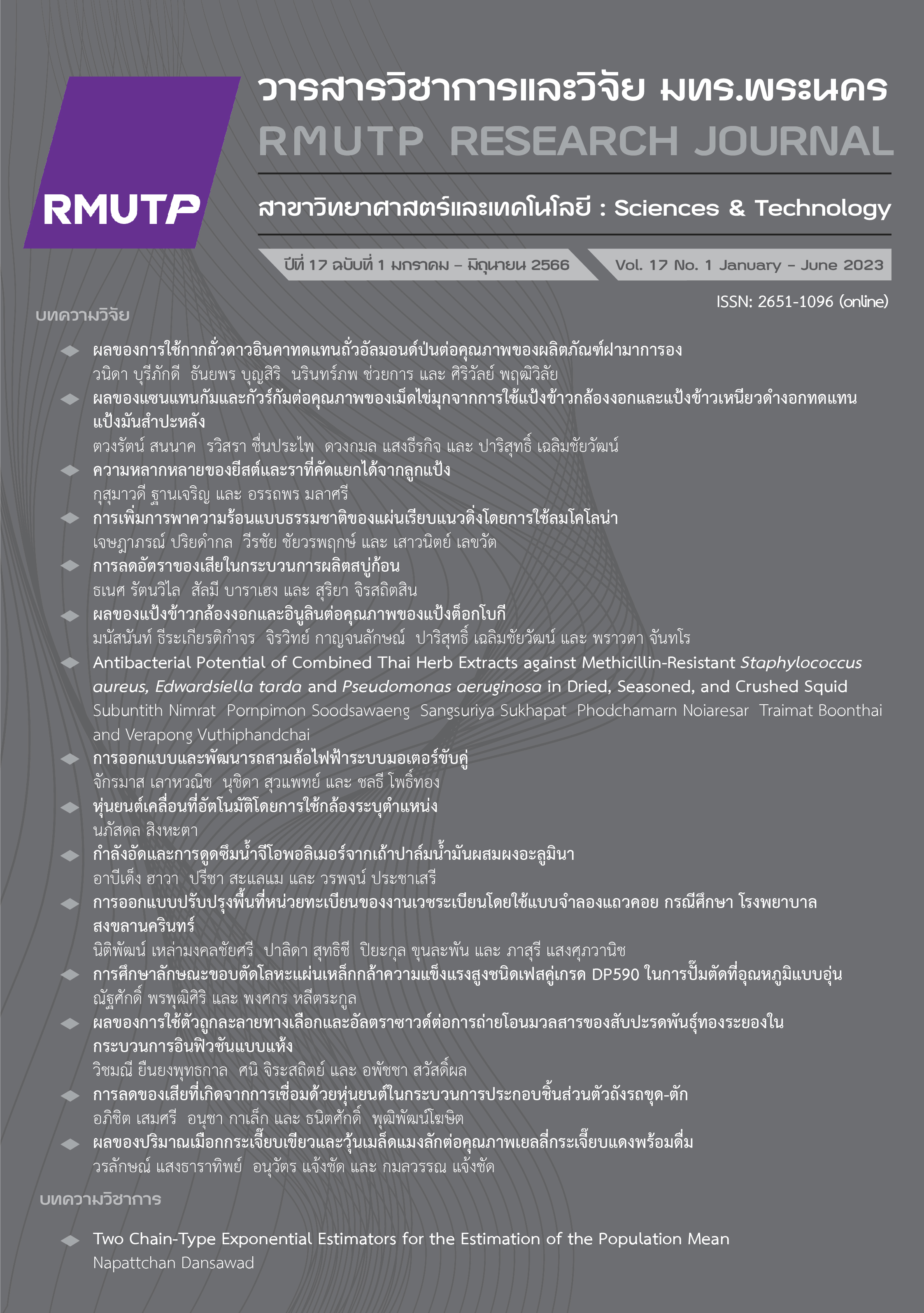Automatic Mobile Robot Indoor with Position Identification by Vision System
Main Article Content
Abstract
This paper presents position identification, a reliable way to identify the current location of the robot using image processing, which can effectively improve the avoid collisions of obstruction with a Light Detection And Ranging (LiDAR) sensor for an autonomous mobile robot. In order to further improve positioning accuracy. The robot under consideration has five functions. Firstly, to overcome the insufficient accuracy of posture when a robot turns, a mobile robot integrated scheme has been investigated for the mobile robots with omni-wheels which can make fixed point turning, so that the robot position remains fixed in the process of changing the direction of motion. Secondly, an additional sensor has been used to detect the object in front of the mobile robot to improve the system that will have the ability to move obstacle avoidance. Thirdly, an algorithm is proposed to feasibly plan the travelling path and avoid obstructing from its initial posture to the destination in an unknown environment. Fourthly, in order to improve the real time performance, a wireless network is more flexible than a cable that allows mobile robots to move freely without any failure. Finally, a possible improvement is to additionally more than one camera, which usually covers a larger area around the robot.
Article Details

This work is licensed under a Creative Commons Attribution-NonCommercial-NoDerivatives 4.0 International License.
ลิขสิทธ์ ของมหาวิทยาลัยเทคโนโลยีราชมงคลพระนครReferences
A.A. Aldair, A.L. Mayyahi and A. Maze, “Maneuvering and Colored Object Tracking for Differential Drive Mobile Robot,” Iraqi Journal for Electrical & Electronic Engineering, vol. 15, no. 1, pp. 47-52, 2019.
J. Ping, C. Liang, G. Hang, Y. Min and X. Jian, “Novel indoor positioning algorithm based on Lidar/inertial measurement unit integrated system,” International Journal of Advanced Robotic Systems, vol. 18, no. 2, pp. 1-11, 2021.
M. Rivai, D. Hutabarat and Z. M. Jauhar Nafis, “2D mapping using omni-directional mobile robot equipped with LiDAR,” Telkomnika, vol. 18, no. 3, pp. 1467-1474, 2020.
L. Juncheng, R. Maopeng, W. Han and X. Lihua, “A Behavior-Based Mobile Robot Navigation Method with Deep Reinforcement Learning,” Unmanned Systems, vol .9, no. 3, pp. 201-209, 2021.
C. Wei, S. Jian, L. Weishuo and Z. Dapeng, “A real-time multi-constraints obstacle avoidance method using LiDAR,” Journal of Intelligent & Fuzzy Systems, vol. 39, no. 1, pp. 119-131, 2020.
S.A. Li, H.M. Feng, K.H. Chen and W.H. Huang, “Highly Autonomous Visualization Map-Generation Mobile Robot System Design Through the Robot Operating System Platform,” Journal of Imaging Science & Technology, vol. 62, no. 3, pp. 1-9, 2020.
X. Yuan, L. Tongqian, S. Bin, Z. Yong, K. Siamak and S. Mingxu, “Indoor Vision/INS Integrated Mobile Robot Navigation Using Multimodel-Based Multifrequency Kalman Filter,” Mathematical Problems in Engineering, pp. 1-8, 2021.
C. Peñaranda, J. Palanca, V. Julian and V. Botti, “A flexible and dynamic mobile robot localization approach,” Logic Journal of the IGPL, vol. 28, no. 2, pp. 197-210, 2020.
C. Pang, X. Zhong, H. Hu, J. Tian, X. Peng and J. Zeng, “Adaptive Obstacle Detection for Mobile Robots in Urban Environments Using Downward-Looking 2D LiDAR,” Sensors, vol. 18, no. 6, 2018.
C. Boris, “Use of Artificial Neural Networks for Fusion of Infrared and Vision Sensors in a Mobile Robot Navigation System,” Annals of DAAAM & Proceedings, vol. 7, no, 1, pp. 80-87, 2020
X. Li, S. Du, G. Li and H. Li, “Integrate Point-Cloud Segmentation with 3D LiDAR Scan-Matching for Mobile Robot Localization and Mapping,” Sensors, vol. 20, no. 1, pp. 237-261, 2019.
K. Misu, and J Miura, “Specific person tracking using 3D LIDAR and ESPAR antenna for mobile service robots,” Advanced Robotics, vol. 29, no. 22, pp. 1483-1495, 2015.
B. Ali, Y. Ayaz, M. Jamil, S.O. Gilani and N Muhammad, “Improved method for stereo vision-based human detection for a mobile robot following a target person,” South African Journal of Industrial Engineering, vol. 26, no. 1, pp. 102-119, 2015.
N. Singhata, “AutonomousMobile Robot Using Vision System and ESP8266 NodeMCU Board,” Current Applied Science and Technology, vol. 21, no. 3, pp. 467-480, 2021.


